Welcome Unit Grammar 课件(15张)
文档属性
| 名称 | Welcome Unit Grammar 课件(15张) | 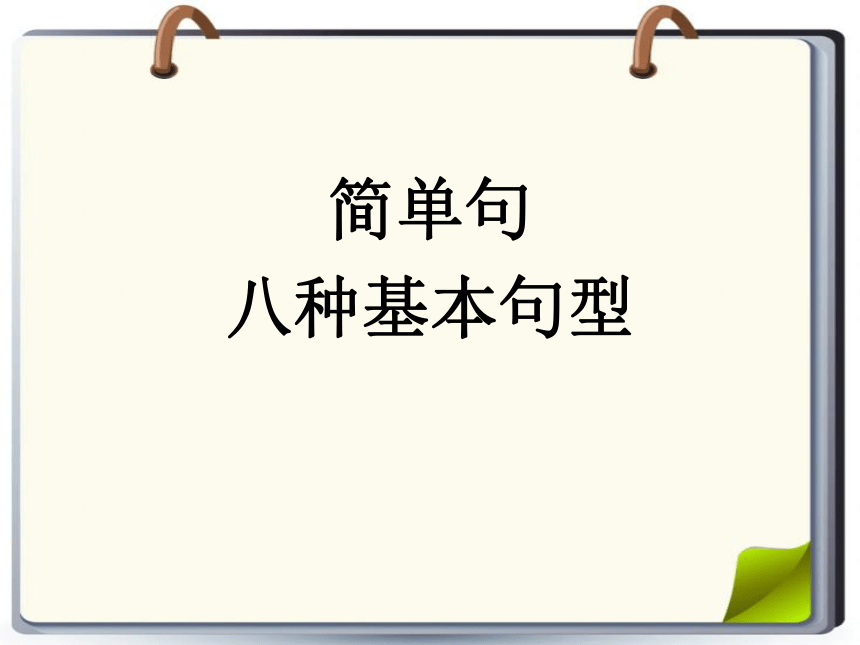 | |
| 格式 | pptx | ||
| 文件大小 | 87.3KB | ||
| 资源类型 | 教案 | ||
| 版本资源 | 人教版(2019) | ||
| 科目 | 英语 | ||
| 更新时间 | 2021-09-03 10:45:13 | ||
图片预览

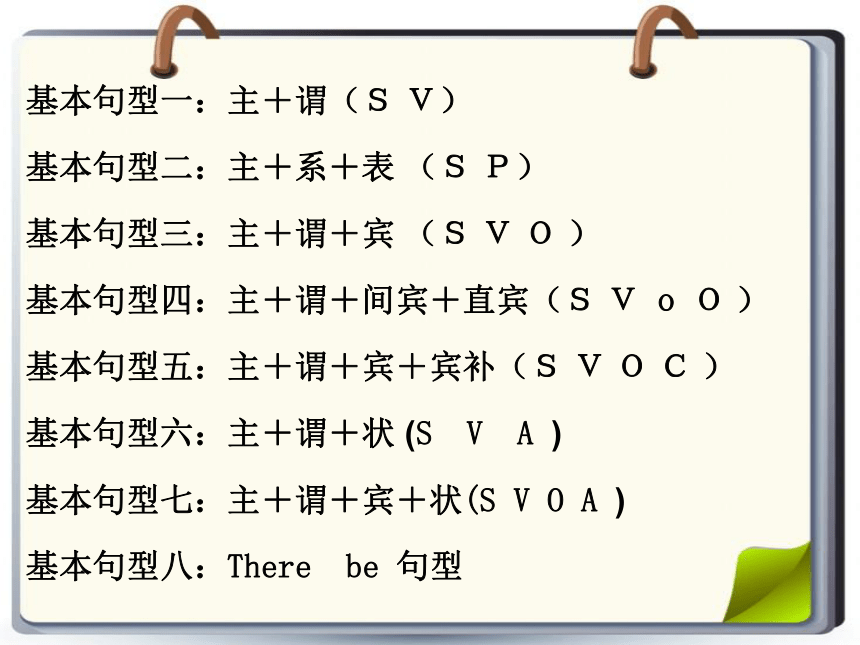
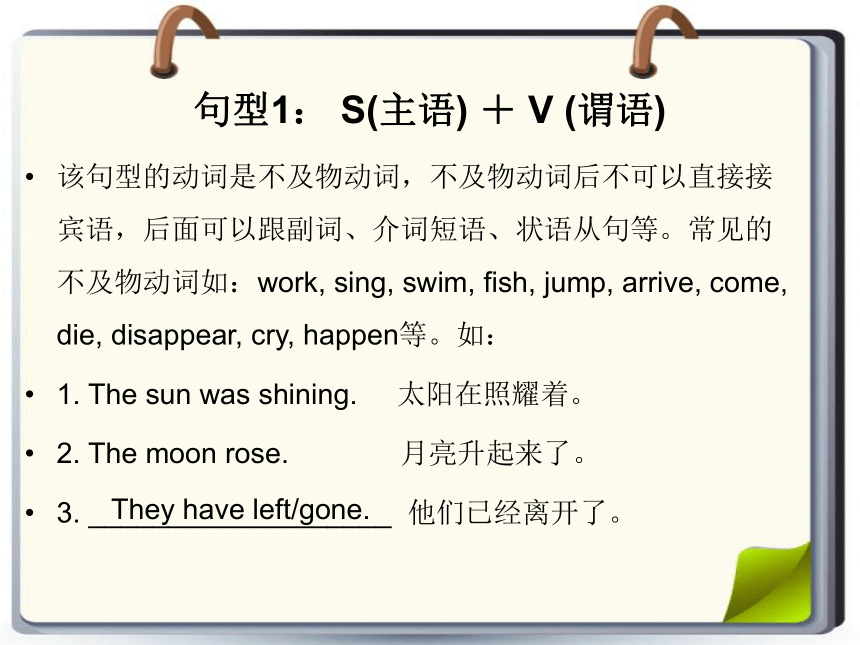
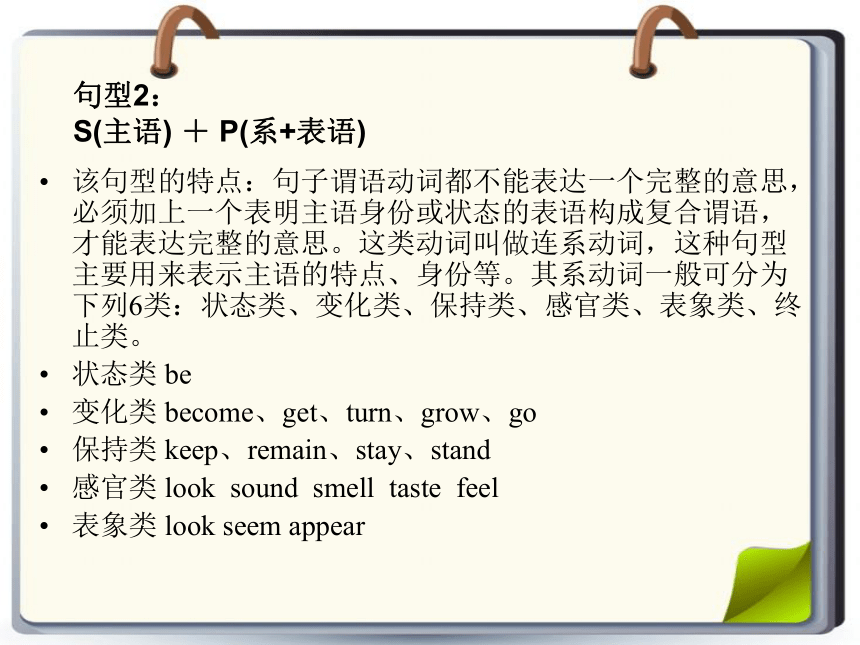
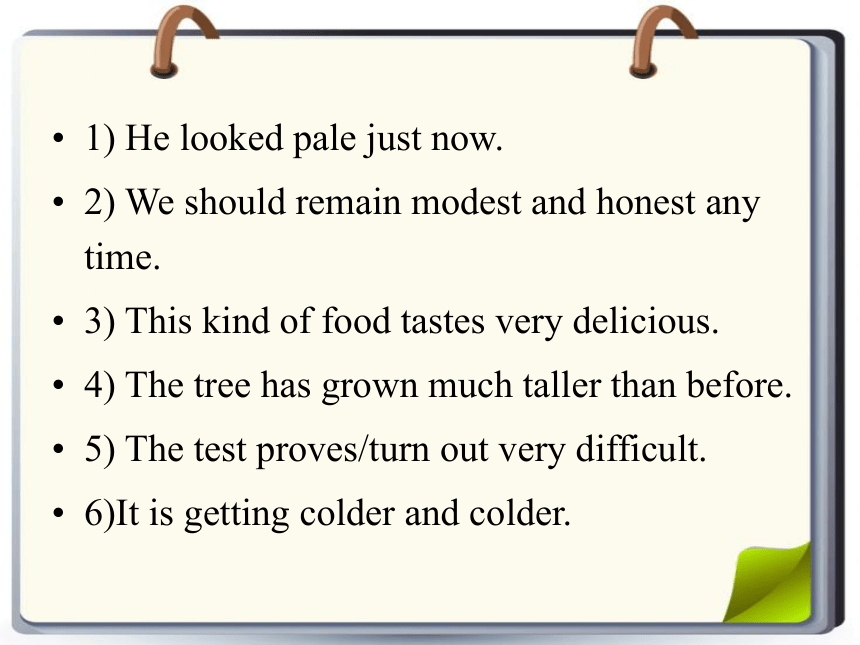
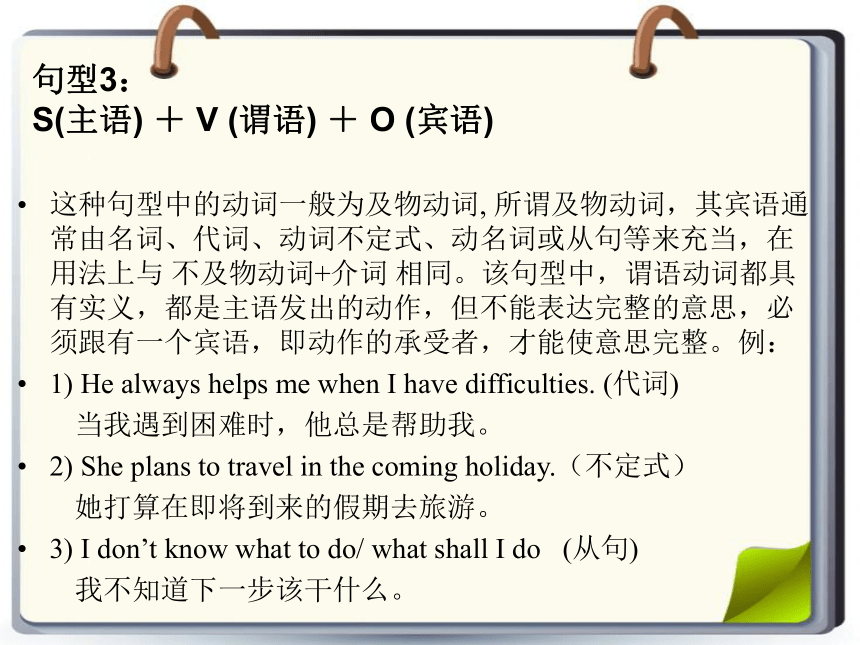
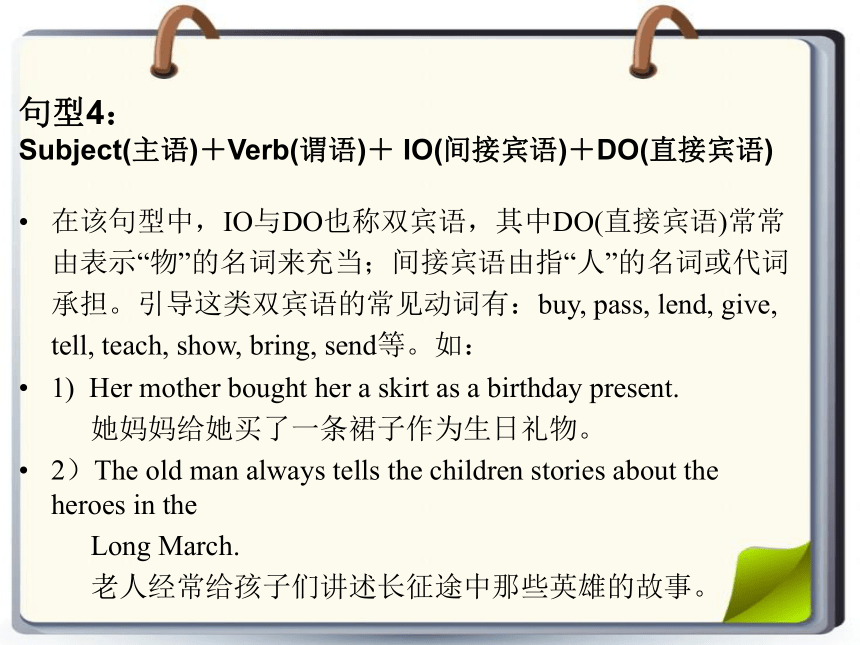
文档简介
(共14张PPT)
简单句
八种基本句型
基本句型一:主+谓(S
V)
基本句型二:主+系+表
(S
P)
基本句型三:主+谓+宾
(S
V
O
)
基本句型四:主+谓+间宾+直宾(S
V
o
O
)
基本句型五:主+谓+宾+宾补(S
V
O
C
)?
基本句型六:主+谓+状
(S
V
A
)
基本句型七:主+谓+宾+状(S
V
O
A
)
基本句型八:There
be
句型
句型1:
S(主语)
+
V
(谓语)
该句型的动词是不及物动词,不及物动词后不可以直接接宾语,后面可以跟副词、介词短语、状语从句等。常见的不及物动词如:work,
sing,
swim,
fish,
jump,
arrive,
come,
die,
disappear,
cry,
happen等。如:
1.
The
sun
was
shining.
太阳在照耀着。
2.
The
moon
rose.
月亮升起来了。
3.
___________________
他们已经离开了。
They
have
left/gone.
句型2:
S(主语)
+
P(系+表语)
该句型的特点:句子谓语动词都不能表达一个完整的意思,必须加上一个表明主语身份或状态的表语构成复合谓语,才能表达完整的意思。这类动词叫做连系动词,这种句型主要用来表示主语的特点、身份等。其系动词一般可分为下列6类:状态类、变化类、保持类、感官类、表象类、终止类。
状态类
be
变化类
become、get、turn、grow、go
保持类
keep、remain、stay、stand
感官类
look
sound
smell
taste
feel
表象类
look
seem
appear
1)
He
looked
pale
just
now.
2)
We
should
remain
modest
and
honest
any
time.
3)
This
kind
of
food
tastes
very
delicious.
4)
The
tree
has
grown
much
taller
than
before.
5)
The
test
proves/turn
out
very
difficult.
6)It
is
getting
colder
and
colder.
句型3:
S(主语)
+
V
(谓语)
+
O
(宾语)
?
这种句型中的动词一般为及物动词,
所谓及物动词,其宾语通常由名词、代词、动词不定式、动名词或从句等来充当,在用法上与
不及物动词+介词
相同。该句型中,谓语动词都具有实义,都是主语发出的动作,但不能表达完整的意思,必须跟有一个宾语,即动作的承受者,才能使意思完整。例:
1)
He
always
helps
me
when
I
have
difficulties.
(代词)
当我遇到困难时,他总是帮助我。
2)
She
plans
to
travel
in
the
coming
holiday.(不定式)
她打算在即将到来的假期去旅游。
3)
I
don’t
know
what
to
do/
what
shall
I
do
(从句)
我不知道下一步该干什么。
句型4:
Subject(主语)+Verb(谓语)+
IO(间接宾语)+DO(直接宾语)
?
在该句型中,IO与DO也称双宾语,其中DO(直接宾语)常常由表示“物”的名词来充当;间接宾语由指“人”的名词或代词承担。引导这类双宾语的常见动词有:buy,
pass,
lend,
give,
tell,
teach,
show,
bring,
send等。如:
1)??Her
mother
bought
her
a
skirt
as
a
birthday
present.
她妈妈给她买了一条裙子作为生日礼物。
2)The
old
man
always
tells
the
children
stories
about
the
heroes
in
the
Long
March.
老人经常给孩子们讲述长征途中那些英雄的故事。
句型5:
S(主语)+V
(谓语)+O
(宾语)+C(补语)
该句型中,动词虽然是及物动词,但是只跟一个宾语还不能表达完整的意思,必须加上一个补充成分来补足宾语,才能使意思完整。这种句型中的“宾语+补语”统称为“复合宾语”。宾语补足语是补充、说明宾语的特点、身份等;或表示让宾语去完成的动作等。担任补语的常常是名词、形容词、副词、介词短语、分词、动词不定式等。常见的动词有:
tell,
ask,
advise,
help,
want,
would
like,
order,
force,
allow等。
1)You
should
keep
the
classroom
clean
and
tidy.
(形容词)你应该让教室保持干净整洁。
2)
We
made
him
our
leader.
(名词)
我们选他当首领。
3)
His
father
told
him
not
to
play
in
the
street.
(不定式)
他父亲告诉他不要在街上玩。
4)My
father
likes
to
watch
the
boys
playing
football.
(现在分词)
5)
Yesterday
I
had
a
picture
taken
with
two
Americans.
(过去分词)
6)
We
found
him
an
honest
man.
我们发现他是一个诚实的人。
句型6
Subject
(主语)
+
Verb
(谓语)
+adverbial(状语)
该句型中的动词是不及物动词,不及物动词后不可以直接接宾语,后面可以跟副词、介词短语等作状语,构成主谓状句型。常见的动词如:work,
sing,
swim,
fish,
jump,
arrive,
come,
die,
disappear,
cry,
happen等。如:
1)
He
runs
every
morning.
(时间状语)
2
)
They
were
swimming
in
the
sea.
(地点状语)
句型7
S(主语)
+
V
(谓语)
+
O
(宾语)
+A
(状)
该句型中的动词为及物动词
用法上与
不及物+介词
相同,
后接宾语,宾语后面跟副词、介词短语等作状语,说明动作发生的情况,构成主谓宾状句型。例:
1.
I
bought
a
book
yesterday.
2.
She
likes
dancing
very
much.
3.He
stared
at
the
moon
for
a
long
time
句型8
There
be
句型
此句型是由
there
+
be
+
主语
+
状语构成,用以表达存在/有。它其实是倒装的一种情况,主语位于谓语动词
be
之后,there
仅为引导词,并无实际语。be
与其后的主语在人称和数量上一致,有时态和情态变化。如,
现在有??
there
is/are
…
过去有??
there
was/were…
将来有??
there
will
be…/there
is
/are
going
to
be...
现在已经有??
there
has/have
been…
eg.
There
have
been
three
accidents
in
one
months.(three
accidents是复数)
eg.
There
has
been
one
cook
who
was
fired
可能有?
there
might
be...
?肯定有?
there
must
be
…/there
must
have
been...
过去一直有?
there
used
to
be
…
?似乎有?
there
seems/seem/seemed
to
be
…
?碰巧有?
there
happen/happens/happened
to
be
…
此句型有时不用be动词,而用
live,
stand,
come,
go,
lie,
remain,
exist,
arrive,等。
3Q!
简单句
八种基本句型
基本句型一:主+谓(S
V)
基本句型二:主+系+表
(S
P)
基本句型三:主+谓+宾
(S
V
O
)
基本句型四:主+谓+间宾+直宾(S
V
o
O
)
基本句型五:主+谓+宾+宾补(S
V
O
C
)?
基本句型六:主+谓+状
(S
V
A
)
基本句型七:主+谓+宾+状(S
V
O
A
)
基本句型八:There
be
句型
句型1:
S(主语)
+
V
(谓语)
该句型的动词是不及物动词,不及物动词后不可以直接接宾语,后面可以跟副词、介词短语、状语从句等。常见的不及物动词如:work,
sing,
swim,
fish,
jump,
arrive,
come,
die,
disappear,
cry,
happen等。如:
1.
The
sun
was
shining.
太阳在照耀着。
2.
The
moon
rose.
月亮升起来了。
3.
___________________
他们已经离开了。
They
have
left/gone.
句型2:
S(主语)
+
P(系+表语)
该句型的特点:句子谓语动词都不能表达一个完整的意思,必须加上一个表明主语身份或状态的表语构成复合谓语,才能表达完整的意思。这类动词叫做连系动词,这种句型主要用来表示主语的特点、身份等。其系动词一般可分为下列6类:状态类、变化类、保持类、感官类、表象类、终止类。
状态类
be
变化类
become、get、turn、grow、go
保持类
keep、remain、stay、stand
感官类
look
sound
smell
taste
feel
表象类
look
seem
appear
1)
He
looked
pale
just
now.
2)
We
should
remain
modest
and
honest
any
time.
3)
This
kind
of
food
tastes
very
delicious.
4)
The
tree
has
grown
much
taller
than
before.
5)
The
test
proves/turn
out
very
difficult.
6)It
is
getting
colder
and
colder.
句型3:
S(主语)
+
V
(谓语)
+
O
(宾语)
?
这种句型中的动词一般为及物动词,
所谓及物动词,其宾语通常由名词、代词、动词不定式、动名词或从句等来充当,在用法上与
不及物动词+介词
相同。该句型中,谓语动词都具有实义,都是主语发出的动作,但不能表达完整的意思,必须跟有一个宾语,即动作的承受者,才能使意思完整。例:
1)
He
always
helps
me
when
I
have
difficulties.
(代词)
当我遇到困难时,他总是帮助我。
2)
She
plans
to
travel
in
the
coming
holiday.(不定式)
她打算在即将到来的假期去旅游。
3)
I
don’t
know
what
to
do/
what
shall
I
do
(从句)
我不知道下一步该干什么。
句型4:
Subject(主语)+Verb(谓语)+
IO(间接宾语)+DO(直接宾语)
?
在该句型中,IO与DO也称双宾语,其中DO(直接宾语)常常由表示“物”的名词来充当;间接宾语由指“人”的名词或代词承担。引导这类双宾语的常见动词有:buy,
pass,
lend,
give,
tell,
teach,
show,
bring,
send等。如:
1)??Her
mother
bought
her
a
skirt
as
a
birthday
present.
她妈妈给她买了一条裙子作为生日礼物。
2)The
old
man
always
tells
the
children
stories
about
the
heroes
in
the
Long
March.
老人经常给孩子们讲述长征途中那些英雄的故事。
句型5:
S(主语)+V
(谓语)+O
(宾语)+C(补语)
该句型中,动词虽然是及物动词,但是只跟一个宾语还不能表达完整的意思,必须加上一个补充成分来补足宾语,才能使意思完整。这种句型中的“宾语+补语”统称为“复合宾语”。宾语补足语是补充、说明宾语的特点、身份等;或表示让宾语去完成的动作等。担任补语的常常是名词、形容词、副词、介词短语、分词、动词不定式等。常见的动词有:
tell,
ask,
advise,
help,
want,
would
like,
order,
force,
allow等。
1)You
should
keep
the
classroom
clean
and
tidy.
(形容词)你应该让教室保持干净整洁。
2)
We
made
him
our
leader.
(名词)
我们选他当首领。
3)
His
father
told
him
not
to
play
in
the
street.
(不定式)
他父亲告诉他不要在街上玩。
4)My
father
likes
to
watch
the
boys
playing
football.
(现在分词)
5)
Yesterday
I
had
a
picture
taken
with
two
Americans.
(过去分词)
6)
We
found
him
an
honest
man.
我们发现他是一个诚实的人。
句型6
Subject
(主语)
+
Verb
(谓语)
+adverbial(状语)
该句型中的动词是不及物动词,不及物动词后不可以直接接宾语,后面可以跟副词、介词短语等作状语,构成主谓状句型。常见的动词如:work,
sing,
swim,
fish,
jump,
arrive,
come,
die,
disappear,
cry,
happen等。如:
1)
He
runs
every
morning.
(时间状语)
2
)
They
were
swimming
in
the
sea.
(地点状语)
句型7
S(主语)
+
V
(谓语)
+
O
(宾语)
+A
(状)
该句型中的动词为及物动词
用法上与
不及物+介词
相同,
后接宾语,宾语后面跟副词、介词短语等作状语,说明动作发生的情况,构成主谓宾状句型。例:
1.
I
bought
a
book
yesterday.
2.
She
likes
dancing
very
much.
3.He
stared
at
the
moon
for
a
long
time
句型8
There
be
句型
此句型是由
there
+
be
+
主语
+
状语构成,用以表达存在/有。它其实是倒装的一种情况,主语位于谓语动词
be
之后,there
仅为引导词,并无实际语。be
与其后的主语在人称和数量上一致,有时态和情态变化。如,
现在有??
there
is/are
…
过去有??
there
was/were…
将来有??
there
will
be…/there
is
/are
going
to
be...
现在已经有??
there
has/have
been…
eg.
There
have
been
three
accidents
in
one
months.(three
accidents是复数)
eg.
There
has
been
one
cook
who
was
fired
可能有?
there
might
be...
?肯定有?
there
must
be
…/there
must
have
been...
过去一直有?
there
used
to
be
…
?似乎有?
there
seems/seem/seemed
to
be
…
?碰巧有?
there
happen/happens/happened
to
be
…
此句型有时不用be动词,而用
live,
stand,
come,
go,
lie,
remain,
exist,
arrive,等。
3Q!
